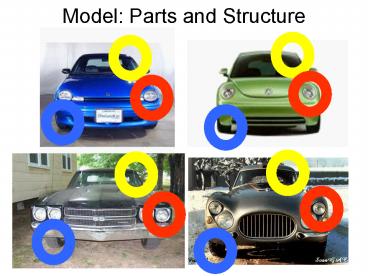ICCV 2005 Beijing, Short Course, Oct 15 PowerPoint PPT Presentation
Title: ICCV 2005 Beijing, Short Course, Oct 15
1
Model Parts and Structure
2
History of Idea
- Fischler Elschlager 1973
- Yuille 91
- Brunelli Poggio 93
- Lades, v.d. Malsburg et al. 93
- Cootes, Lanitis, Taylor et al. 95
- Amit Geman 95, 99
- Perona et al. 95, 96, 98, 00, Huttenlocher et
al. 00 - Many papers since 2000
3
Representation
- Object as set of parts
- Generative representation
- Model
- Relative locations between parts
- Appearance of part
- Issues
- How to model location
- How to represent appearance
- Sparse or dense (pixels or regions)
- How to handle occlusion/clutter
Figure from Fischler73
4
Example scheme
- Model shape using Gaussian distribution on
location between parts - Model appearance as pixel templates
- Represent image as collection of regions
- Extracted by template matching normalized-cross
correlation - Manually trained model
- Click on training images
5
Sparse representation
Computationally tractable (105 pixels ? 101 --
102 parts) Generative representation of class
Avoid modeling global variability Success in
specific object recognition
- Throw away most image information - Parts need
to be distinctive to separate from other classes
6
The correspondence problem
- Model with P parts
- Image with N possible locations for each part
- NP combinations!!!
7
Connectivity of parts
- Complexity is given by size of maximal clique in
graph - Consider a 3 part model
- Each part has set of N possible locations in
image - Location of parts 2 3 is independent, given
location of L - Each part has an appearance term, independent
between parts.
Shape Model
L
3
2
8
Different graph structures
6
1
3
5
3
2
3
2
1
2
1
4
5
4
6
4
5
6
Fully connected
Star structure
Tree structure
O(N6)
O(N2)
O(N2)
- Sparser graphs cannot capture all interactions
between parts
9
Some class-specific graphs
- Articulated motion
- People
- Animals
- Special parameterisations
- Limb angles
Images from Kumar05, Feltzenswalb05
10
Regions or pixels
- Regions ltlt Pixels
- Regions increase tractability but lose
information - Generally use regions
- Local maxima of interest operators
- Can give scale/orientation invariance
Figures from Kadir04
11
How to model location?
- Explicit Probability density functions
- Implicit Voting scheme
- Invariance
- Translation
- Scaling
- Similarity/affine
- Viewpoint
12
Explicit shape model
- Probability densities
- Continuous (Gaussians)
- Analogy with springs
- Parameters of model, ? and ?
- Independence corresponds to zeros in ?
13
Shape
- Shape is what remains after differences due to
translation, rotation, and scale have been
factored out. Kendall84 - Statistical theory of shape Kendall, Bookstein,
Mardia Dryden
Y
V
U
X
Shape Space
Figure Space
Figures from Leung98
14
Representation of appearance
- Dependencies between parts
- Common to assume independence
- Need not be
- Symmetry
- Needs to handle intra-class variation
- Task is no longer matching of descriptors
- Implicit variation (VQ appearance)
- Explicit probabilistic model of appearance (e.g.
Gaussians in SIFT space or PCA space)
15
Representation of appearance
- Invariance needs to match that of shape model
- Insensitive to small shifts in translation/scale
- Compensate for jitter of features
- e.g. SIFT
- Illumination invariance
- Normalize out
- Condition on illumination of landmark part
16
Parts and Structure demo
- Gaussian location model star configuration
- Translation invariant only
- Use 1st part as landmark
- Appearance model is template matching
- Manual training
- User identifies correspondence on training images
- Recognition
- Run template for each part over image
- Get local maxima ? set of possible locations for
each part - Impose shape model - O(N2P) cost
- Score of each match is combination of shape model
and template responses.
17
Demo images
- Sub-set of Caltech face dataset
- Caltech background images
18
(No Transcript)
19
Learning using EM
- Task Estimation of model parameters
- Chicken and Egg type problem, since we initially
know neither - Model parameters
- - Assignment of regions to parts
- Let the assignments be a hidden variable and use
EM algorithm to learn them and the model
parameters
20
Learning procedure
- Find regions their location appearance
- Initialize model parameters
- Use EM and iterate to convergence
E-step Compute assignments for which regions
belong to which part M-step Update model
parameters
- Trying to maximize likelihood consistency in
shape appearance
21
Example scheme, using EM for maximum likelihood
learning
1. Current estimate of ?
2. Assign probabilities to constellations
Large P
...
Image i
Image 1
Image 2
Small P
3. Use probabilities as weights to re-estimate
parameters. Example ?
Large P
x
Small P
x
new estimate of ?
22
Learning Shape Appearance simultaneously
Fergus et al. 03

